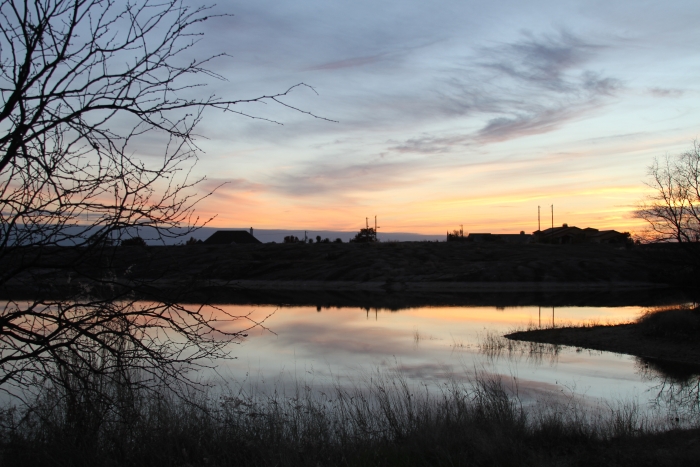Lake LBJ will begin drawdown Monday

Glynis Crawford Smith/The Highlander
On Christmas Eve, all was calm and all was quiet in Granite Shoals, but come Monday the drawdown of Lake LBJ will begin and residents will be scouting the nearest park depository for refuse from the clean up.
By Glynis Crawford Smith
The Highlander
Waterfront property owners will begin a flurry of activity Jan. 2 when the drawdown of Lake LBJ promised by the Lower Colorado River Authority (LCRA) begins.
Until about Feb. 13, property owners will be able to work on docks and retaining walls, perform dredging, debris removal and other maintenance work. There are limitations on work, including a prohibition against burning debris in the lakebed or dumping dredged material in the lakebed or along the shoreline.
The problems were rife in the City of Granite Shoals during the last lowering of Lake LBJ, in 2008, when parks and, most egregiously, the Granite Shoals Airport became dumping grounds.
In response, Granite Shoals citizens will find dumpsters in a dozen city parks for refuse disposal.
“We have chosen 20-yard dumpsters with gates that drop down, so pickups and back right up to the dumpsters to off load,” said City Manager Ken Nickel. “People can offload seaweed, brush and items removed from the lake”
No construction debris, household trash, hazardous waste or mattresses will be allowed. And, the dumpsters do not solve the problem of the mud, muck, dirt and fill dredged from the lake. That disposal still will fall to property owners.
One thing is certain this year: the Granite Shoals Airport is not a disposal location.
“Persons dumping at the airport this year will be prosecuted,” said Nickel.
He did note that the city's solid waste disposal program offers free large-item pick up every other Friday for furniture, mattresses and non-refrigerated appliances. Batteries, chemicals, paints and similar items have to wait for a hazardous waste disposal event.
Dumpsters will be located at four parks on Shorewood Drive intersections: Park #3 – Castlebriar Park; Park #4 – Castleshoals Park; Park #5 – Briar Park, and Park #6 – Bluebriar Park.
Other locations will include: Park #8 – Hillcrest Park, near the entrance to Beaver Island; Park #11 – Lakeview Park, on the Lakeview Lane peninsula; Park #12 – Robin Hood Park, on the Robin Hood Lane peninsula; Park #13 Belaire Park, on Belaire at Pine Drive; Park #14 – Timberhill Park, on Timberhill at Hilldale Drive; Park #15 – Clear Cove Park, on the Clear Cove Drive peninsula; Park #16 – Crockett Park, on Sherwood Forest Drive between Glen Forest Drive and Prairie Creek Road, and Park #18 – Woodland Hills Park at the lake inlet on Hillside Drive.
Questions about disposal in Granite Shoals can be directed to City Secretary Elaine Simpson at 830-598-2424, extension 303, or via email at citysecretary@graniteshoals.org. Building permit questions about work to take place can be answered by the code compliance officers, Preston Williams or Mike Bishop, also at 830-598-2424.
In Horseshoe Bay residents are being encouraged to check with the LCRA on regulations for dredging, construction or debris disposal.
“It is very likely that the sediments on the lake bed will be soft and slippery, so caution should be taken if residents are going out on exposed areas,” said Jeffrey “Jeff” A. Koska, director of community services.
“We are hoping this action will significantly reduce the Milfoil issue for future years, as the plants should die from being exposed to the air and cold.”
The LCRA will not allow shoreline work in excess of 500 feet or dredging more than 2,000 cubic yards without notification and approval by LCRA and U.S. Army Corps of Engineers (USACE) prior to the start of work. Also not allowed is reclamation of land lost to erosion or flood damage or new construction.
Maintenance dredging, debris removal and repair work on existing retaining walls during the drawdown can be done under LCRA’s permit with the USACE, but the work must be registered with LCRA. Registration forms are available:
-
Online at lcra.org/lakelowerings.
-
By calling LCRA Water Quality Protection, 512-578-2324.
-
In person at the LCRA Western Maintenance Facility, 2643 Wirtz Dam Road, near Marble Falls, from 9 a.m.-12:30 p.m. and 1:30-3 p.m. Monday-Friday.
The LCRA will be fielding questions and providing information about its rules and permits on the website www.lcra.org, by email at ask.lcra@lcra.org, or by calling LCRA Water Quality Protection at 512-578-2324.
The earliest lowering considered for Lake Marble Falls is 2018, but Lake Austin will be lowered in the same six-week period as Lake LBJ this year.
Lake LBJ will be lowered about 4 feet – from its normal operating range of 824.4 to 825 feet above mean sea level (msl) to a range of 820.2-820.8 feet msl. The volume of lowering Lake LBJ about 4 feet is about 23,000 acre-feet. (An acre-foot is 325,851 gallons.)
Lake Austin will be lowered about 10 feet – from its normal operating range of 491.8 to
492.8 feet msl to a range of 481.2 to 482.8 feet msl. The volume of lowering Lake Austin
about 10 feet is about 13,000 acre feet.
Questions about work on Lake Austin may be directed to the City of Austin Development Assistance Center, One Texas Center, 505 Barton Springs Road, 512-974-6370, or Liz Johnston in the Austin Watershed Protection Office at 512-974-2619.






